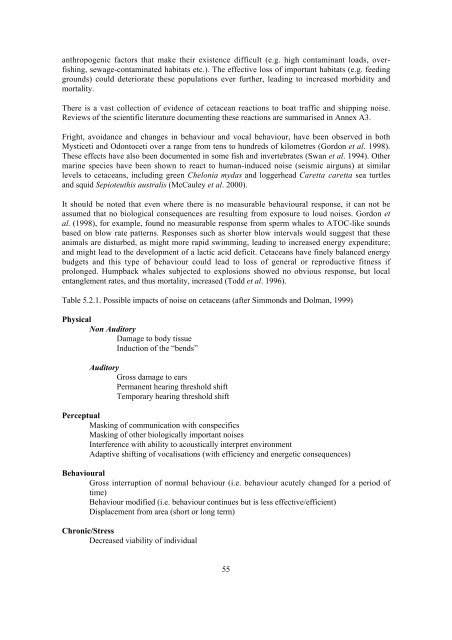Oceans of noise - Whale and Dolphin Conservation Society
Oceans of noise - Whale and Dolphin Conservation Society
Oceans of noise - Whale and Dolphin Conservation Society
- No tags were found...
Create successful ePaper yourself
Turn your PDF publications into a flip-book with our unique Google optimized e-Paper software.
anthropogenic factors that make their existence difficult (e.g. high contaminant loads, overfishing,sewage-contaminated habitats etc.). The effective loss <strong>of</strong> important habitats (e.g. feedinggrounds) could deteriorate these populations ever further, leading to increased morbidity <strong>and</strong>mortality.There is a vast collection <strong>of</strong> evidence <strong>of</strong> cetacean reactions to boat traffic <strong>and</strong> shipping <strong>noise</strong>.Reviews <strong>of</strong> the scientific literature documenting these reactions are summarised in Annex A3.Fright, avoidance <strong>and</strong> changes in behaviour <strong>and</strong> vocal behaviour, have been observed in bothMysticeti <strong>and</strong> Odontoceti over a range from tens to hundreds <strong>of</strong> kilometres (Gordon et al. 1998).These effects have also been documented in some fish <strong>and</strong> invertebrates (Swan et al. 1994). Othermarine species have been shown to react to human-induced <strong>noise</strong> (seismic airguns) at similarlevels to cetaceans, including green Chelonia mydas <strong>and</strong> loggerhead Caretta caretta sea turtles<strong>and</strong> squid Sepioteuthis australis (McCauley et al. 2000).It should be noted that even where there is no measurable behavioural response, it can not beassumed that no biological consequences are resulting from exposure to loud <strong>noise</strong>s. Gordon etal. (1998), for example, found no measurable response from sperm whales to ATOC-like soundsbased on blow rate patterns. Responses such as shorter blow intervals would suggest that theseanimals are disturbed, as might more rapid swimming, leading to increased energy expenditure;<strong>and</strong> might lead to the development <strong>of</strong> a lactic acid deficit. Cetaceans have finely balanced energybudgets <strong>and</strong> this type <strong>of</strong> behaviour could lead to loss <strong>of</strong> general or reproductive fitness ifprolonged. Humpback whales subjected to explosions showed no obvious response, but localentanglement rates, <strong>and</strong> thus mortality, increased (Todd et al. 1996).Table 5.2.1. Possible impacts <strong>of</strong> <strong>noise</strong> on cetaceans (after Simmonds <strong>and</strong> Dolman, 1999)PhysicalNon AuditoryDamage to body tissueInduction <strong>of</strong> the “bends”AuditoryGross damage to earsPermanent hearing threshold shiftTemporary hearing threshold shiftPerceptualMasking <strong>of</strong> communication with conspecificsMasking <strong>of</strong> other biologically important <strong>noise</strong>sInterference with ability to acoustically interpret environmentAdaptive shifting <strong>of</strong> vocalisations (with efficiency <strong>and</strong> energetic consequences)BehaviouralGross interruption <strong>of</strong> normal behaviour (i.e. behaviour acutely changed for a period <strong>of</strong>time)Behaviour modified (i.e. behaviour continues but is less effective/efficient)Displacement from area (short or long term)Chronic/StressDecreased viability <strong>of</strong> individual55




